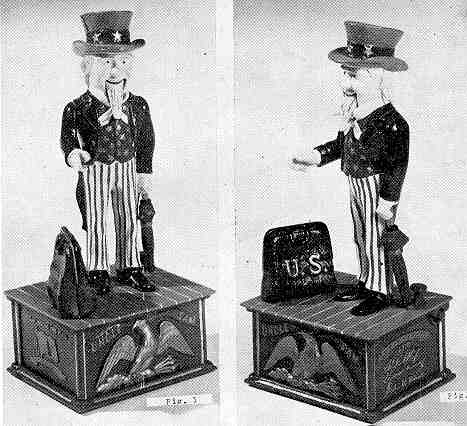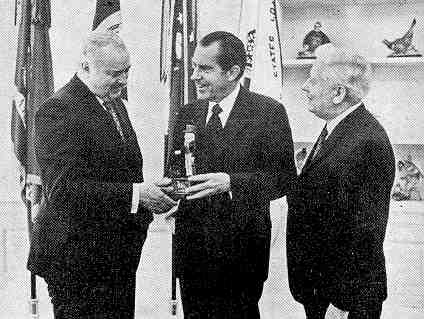A Unique Uncle Sam Bank
by F.H. Griffith - HOBBIES Magazine - August, 1973

After a necessary waiting period the writer now has proper clearance to pass along information and details with respect to a very special modern mechanical bank. The circumstances surrounding this unique Uncle Sam Bank are as follows —
Early in the fall of 1969 Gordon M. Metcalf, then Chairman of the Board of Sears, Roebuck and Co., accepted President Nixon’s request to serve as Chairman of the 1970 U.S. Industrial Payroll Savings Campaign.
One of Mr. Metcalf’s first tasks was to select a committee of 45 top industrial leaders to help reach the high quotas he intended to set. He chose well. Together, these men achieved better than 110 per cent of their ambitious goal, with over 2,200,000 new or increased pledges.
For many years, previous Chairmen of this campaign had recognized the efforts of their committee with a memento of service. But Mr. Metcalf wanted to give more than just a memento. He wanted to give each member a remembrance that was both unique and appropriately related to the job they had done.
In searching for such an unusual item he remembered having seen Wally Tudor’s extensive collection of antique mechanical banks. So he talked to him about the possibility of giving each man an original bank much like the ones in Wally’s collection.

Wally explained the difficulty anyone would have in acquiring so many different banks of comparable value and condition, but he thought the problem wasn’t unsolvable. He suggested they take the most appropriate bank they could find and have it recreated in a limited edition. The Uncle Sam Bank from Wally Tudor’s private collection became the perfect choice.
As soon as the decision was made, the job was turned over to the Research and Engineering Department of Sears. Wally reasoned . . . they’ve probably got enough talent to launch a Sputnik, so they ought to have enough to make a cast iron mechanical bank of the same high quality that craftsmen in Civil War days were able to achieve. And he was right.
One of the first decisions the research people made was not to make a replica of the old bank by casting from the original. Instead, they decided to create a new original by scaling the old bank 1¼ inches shorter and making new molds that could reproduce the quality they were determined to achieve.
Many highly skilled craftsmen labored on the detailing of the new Uncle Sam Mechanical Bank. When the casting was finally completed, a search was made for an artisan with the talent, skill and patience to hand-paint each bank, exact in every detail, with the larger model after which it was patterned. They found such a talent in a young black man paralyzed from the waist down.
And so 99 banks were made, each embossed at the bottom with its own individual number from 1 to 99. And then the mold was destroyed.
At the left side of the new bank the official Savings Bond logo is embossed. On the right side there is an inscription that reads, "U.S. Savings Bonds . . . 1970." And under the inscription are the signatures of Richard M. Nixon; David M. Kennedy, then United States Secretary of the Treasury, and Gordon M. Metcalf.
This memento of a job well done was sent to the 45 members of the 1970 Savings Bond Campaign Committee, to the previous National Bond Campaign Chairmen, to key treasury personnel, and to the officers of Sears.
What could have been more fitting than for Uncle Sam to be the symbol of this unique "thank you" gesture?
So there you have the story on a very interesting mechanical with solid authentic background. Quite important is the fact that each bank has individually numbered parts inside. That is to say, the inside parts of the No. 1 bank are numbered No. 1, and this follows for each bank through No. 99 with the inside parts numbered 99. This is really carrying detail to the final point, and there is no other mechanical made in this fashion. To accomplish this required a considerable amount of extra time, detail and patience in assembly.
The name of the young man who did the careful painting is Harold Dickens and he deserves full credit for his meticulous work.
Figure 1 shows the bank with the sideplate having the official Savings Bond logo thereon. Figure 2 shows the sideplate with the three signatures. In Figure 3 Gordon M. Metcalf is presenting the No. 1 bank to President Nixon as David M. Kennedy looks on.
A modern mechanical with charisma and impressive important background. The writer can only wish good luck to all collectors who will want to add this limited production bank to their respective collections.
